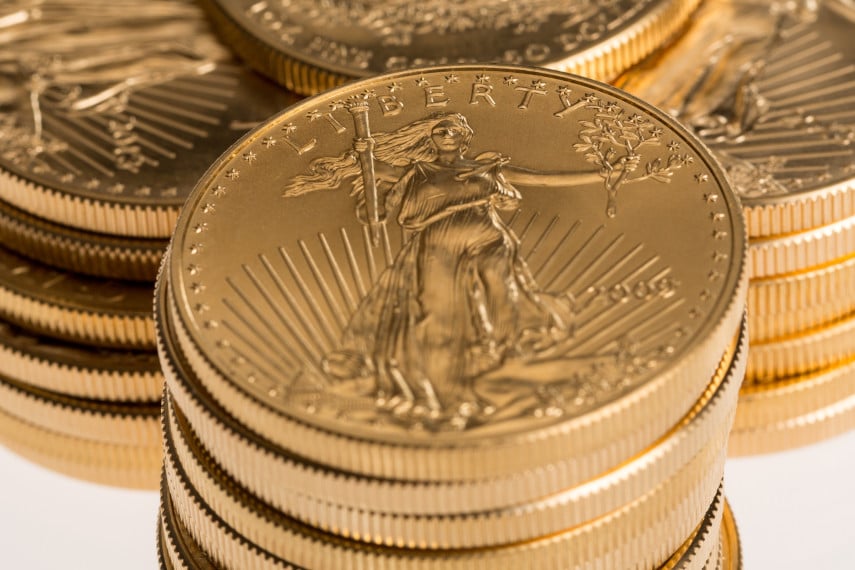
Gold demand from investors has been strong for over a year. Gold demand from central banks is the highest it’s been in over half a century. The economy seems to be on the verge of a slowdown and recession. So why did the gold price just drop over $50 an ounce last week?
The day-to-day price movements of gold, or any financial asset, for that matter, can sometimes be a cause of consternation to investors. But it’s important to realize that, no matter the short-term fluctuations, remaining focused on the long term and staying the course can be vitally important if you’re a gold owner.
Markets Digesting Data
Markets last week dealt with the aftermath of the Federal Reserve’s decision to raise the target federal funds rate by a quarter percentage point, and the comments made afterwards by Fed Chairman Jay Powell which were deemed to be relatively dovish. Markets seem to think that the Fed’s fight against inflation is paying dividends, which is why stocks seemed to do well while gold fell.
This week markets waited again for Chairman Powell’s speech in DC, hanging on his every word. He didn’t say much that was different from last week, reiterating that he believed that the process of disinflation had begun, but that it would take some time before inflation would finally be overcome. And the gold price jumped around quite a bit as markets took their time digesting Powell’s remarks.
There’s a lesson to be learned here about the duality of gold markets. For as much as long-term price moves can be influenced by investment demand and other macro factors, short-term movements are driven by the more mundane and hum-drum factors that influence markets on a daily basis.
A speech given by a central banker, new jobs or inflation reports, or even inventory off-loading by funds and financial institutions can be factors that drive the gold price up or down in the short term. As much as many of us like to hold gold for the long term and realize that gold can be an effective long-term store of wealth, there are still a lot of people who trade gold in the short-term, whether that’s day to day, week to week, or month to month.
With so much activity in gold markets, given their international reach and 24/7 operations, there are always going to be things affecting the gold price in the short term. They don’t even have to be events that are taking place in the US or even in the West. With India, China, and Russia all being big buyers of gold, events there can impact the gold price as well.
Staying the Course
While we all understand that prices don’t always move up and down in predictable ways, in predictable patterns, or in consistent directions, it’s tough to translate the intellectual understanding of that with our desire for our chosen asset to do well. And it can be even tougher when we “know” that asset should be doing better.
In the case of gold, for instance, we know that inflation is high, the risk of recession is growing, and the economy is slowing down. We don’t trust the Fed, and experience tells us that the Fed probably isn’t going to beat inflation, so markets shouldn’t get excited when the Fed acts. Gold demand has been elevated for some time, with mints struggling at times to produce enough coins to satisfy investor demand. Yet gold still hasn’t skyrocketed like many people expected it to. Will it take the actual coming of the recession to get the gold price to continue strong upward growth?
If we look at 2008 for the last blueprint of gold’s price growth, that may very well be the case. Gold performed well during the early part of the recession, then backtracked when markets panicked and financial institutions came under pressure. But it quickly rebounded, and by the time markets were at their nadir, gold was well on its way to all-time highs.
That should encourage anyone who thinks that gold is underperforming today. While we may expect a recession, and could even be in the early stages of one, things haven’t gotten really bad yet. Once the worst part of the recession is upon us, then gold may take off.
In the meantime, gold’s not taking off in price means that it’s still relatively affordable for most people. So if you were looking for an opportunity to keep buying gold before it takes off in price, now’s the time.
Many people kicked themselves after the 2008 crisis when they saw how well gold performed. Many kicked themselves in the past few years as they thought gold was overrated and stocks were the way to go. But gold’s price growth since 2020 has made many people remember just how important gold can be as a store of value and protector of wealth during tough times.
If we end up facing a recession along the lines of 2008, having gold in your portfolio could help protect you against loss, and could help you recover quicker in the aftermath. But you have to buy gold before things get bad, before prices skyrocket, and before markets tumble.
Timing markets is notoriously difficult, and waiting until the “right” time could mean missing out. So call the experts at Goldco today to learn more about how you can make gold a part of your portfolio.
Whether you’re interested in protecting your retirement savings with a gold IRA or just buying a few gold coins to store at home, Goldco has the products and services you need to make that happen.
With over $1 billion in precious metals placements and thousands of satisfied customers, we work hard to make sure that you reap the rewards of buying gold. Call Goldco today to find out more about how gold can help safeguard your assets.






